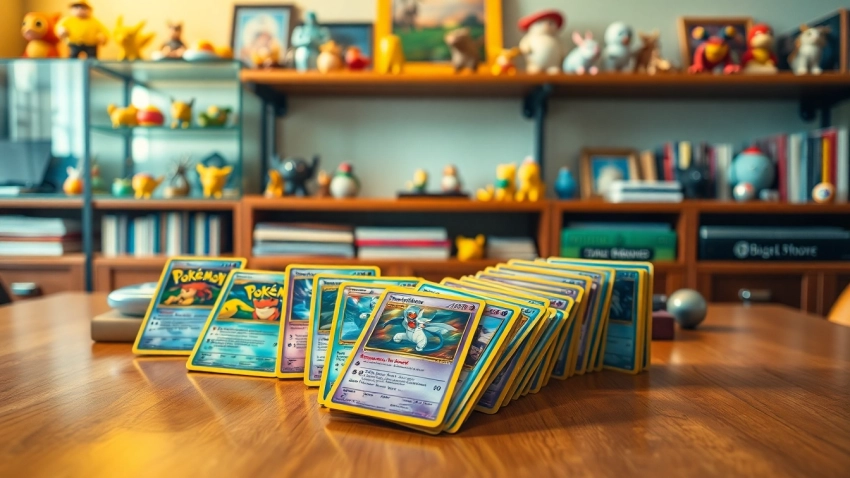
Unlocking the World of Real Pokémon Cards: Your Guide to Authentic Collectibles
The Ultimate Guide to Real Pokémon Cards
In the world of Pokémon trading card games (TCG), distinguishing between real and counterfeit cards is a skill that every collector and player should develop. With the increasing popularity of Pokémon cards, especially among collectors and enthusiasts, it’s vital to understand the nuances of authentic cards. This guide aims to educate you on identifying real Pokémon cards, engaging in the community, and expanding your collection effectively.
Understanding Real vs. Fake Pokémon Cards
As the demand for Pokémon cards surges, so does the prevalence of counterfeits. Identifying fake cards can save collectors from financial losses and enhance their gaming experience. Below are strategies to differentiate between real and fake Pokémon cards.
Visual Inspection
The first step in identifying a fake card is through visual inspection. Authentic Pokémon cards have specific designs, colors, and textures that are difficult to replicate. Look for the following:
- Colors: Real cards boast vibrant colors, while fakes often appear washed out.
- Text: Check for spelling errors or inconsistent fonts on the cards.
- Shiny Effects: The holographic effects on legitimate cards are distinct and shiny, while forgeries may look dull or glittery.
Physical Properties
Another effective method to distinguish between real and fake cards is through their physical properties. Observe the weight and feel of the card:
- Weight: Genuine Pokémon cards have a specific weight. If a card feels noticeably lighter, it may be a counterfeit.
- Bend Test: Authentic cards have a certain flexibility and rigidity. A card that bends easily without snapping back is likely fake.
Light Test
Hold a card up to a light source. Genuine Pokémon cards have a unique layering structure, which allows some light to filter through but not fully penetrate. If you can see through the card too easily, it may be fake.
Key Features of Authentic Pokémon Cards
Recognizing the distinctive features that define a genuine Pokémon card is crucial for collectors. Here are several key characteristics:
- Card Stock: Authentic cards are made from high-quality cardboard with a specific texture that feels different compared to fakes.
- Registration Marks: Examine the back of the card for the Pokémon logo and copyright details that should be immaculate.
- Ruler Marks: Each card should measure 63mm x 88mm. Measurements that deviate from this standard may indicate a counterfeit.
Top Places to Buy Real Pokémon Cards
When looking to purchase real Pokémon cards, it’s vital to choose reputable sources. Listing a few trusted retailers that specialize in authentic Pokémon products can also help:
- Pokémon Center: The official website for Pokémon, this retailer offers a range of authentic trading cards and merchandise.
Visit Pokémon Center - TCGPlayer: A popular marketplace for trading card games, TCGPlayer allows users to buy and sell cards at competitive prices.
- Local Game Stores: Consider visiting local game stores that frequently host Pokémon events; they often carry legitimate Pokémon cards.
Recognizing the Value of Real Pokémon Cards
Understanding the value of Pokémon cards is essential for collectors, whether they are looking to buy, sell, or trade. Various factors influence this value, including rarity, condition, and demand.
Factors that Determine Card Value
Knowing what affects a card’s value can significantly benefit collectors:
- Rarity: Limited-edition cards, promotional cards, and those featuring rare Pokémon generally hold higher value.
- Demand: Cards from popular sets or with fan-favorite Pokémon tend to be in higher demand, which influences their price.
- Condition: Cards in mint condition are worth significantly more than those with visible wear and tear.
Common Misconceptions About Card Pricing
Many collectors fall prey to myths regarding card pricing. Here are a few common misconceptions:
- All Old Cards are Valuable: While some vintage cards are worth a lot, not all have maintained value. Factors like condition and market demand play a crucial role.
- Price Guides Are Always Accurate: While guides can provide a baseline, actual market pricing fluctuates based on real-time sales and demand.
- Graded Cards Only: While graded cards can fetch higher amounts in auctions, many ungraded cards also hold significant value among collectors.
How to Assess Card Condition
Assessing a card’s condition accurately is critical for determining its value. Here are steps you can follow:
- Surface Inspection: Look for scratches, dents, or any other imperfections.
- Edge and Corner Wear: Evaluate the edges and corners for rounding or fraying.
- Centering: Properly centered cards hold greater value compared to those that are off-center.
Collecting Real Pokémon Cards: Building Your Collection
Building a successful Pokémon card collection takes time, patience, and a strategic approach. Here’s how to create a collection that reflects your interests and investment goals.
Types of Cards to Consider for Collecting
When planning your collection, consider focusing on various types of Pokémon cards:
- Holofoil Cards: These visually appealing cards can be a great addition to any collection.
- Full Art Cards: Full art cards have captivating designs that often make them highly sought after.
- Rare Promo Cards: Limited promotional cards can hold significant value due to their scarcity.
Protecting Your Collection: Best Practices
Caring for your cards is essential for preserving their value. Here are some best practices for card protection:
- Storage Solutions: Use quality card sleeves, toploaders, and binders to protect your cards from dust and damage.
- Climate Control: Store your collection in a climate-controlled environment to prevent damage from humidity and temperature fluctuations.
Community Resources for Collectors
Engaging with the Pokémon card community can provide valuable insights and support:
- Online Forums: Participate in forums like r/PokemonTCG for discussions on cards, pricing, and collecting tips.
- Social Media Groups: Join Facebook or Discord groups dedicated to Pokémon card collecting for real-time updates and trades.
Where to Find Real Pokémon Cards Online
If you’re looking to purchase cards online, it’s crucial to navigate the vast internet efficiently:
Best Online Retailers for Authentic Pokémon Cards
When shopping online, here are a few recommended retailers:
- Amazon: Trusted sellers often offer Pokémon cards, but be cautious and and check seller reviews.
- eBay: A great platform for finding rare cards; be sure to verify seller ratings before making purchases.
Utilizing Marketplaces Safely
Marketplaces can be a double-edged sword; while they provide access to numerous listings, buyers must remain vigilant:
- Research Sellers: Check seller ratings and reviews to ensure you’re dealing with reputable sources.
- Ask Questions: Don’t hesitate to ask sellers questions about card conditions or authenticity before making a purchase.
Reviewing Sellers: What to Look For
Before finalizing purchases, reviewing the seller is crucial:
- Return Policy: Understand the seller’s return policy in case the card does not meet your expectations.
- Shipping Methods: Be sure the seller uses reliable shipping methods to protect your investment during transit.
Sharing Passion with Fellow Collectors
Sharing your passion for Pokémon cards enhances the collecting experience. Engaging with the community can lead to new friendships and valuable knowledge.
Joining Pokémon Card Collecting Communities
Whether online or locally, connecting with fellow collectors can provide support and enhance your knowledge:
- Local Meetups: Attend local trading events or tournaments to meet fellow enthusiasts face-to-face.
- Online Communities: Engage in discussions on platforms like Reddit or Discord, where you can share tips and experiences.
Attending Local and Online Events
Take advantage of events to learn, trade, and network:
- Tournaments: Participate in competitive or casual tournaments to test your decks while connecting with fellow gamers.
- Trade Shows: Join trade shows or conventions that focus on collectibles to meet like-minded individuals.
Documenting Your Collection Journey
Keeping a record of your collection allows for tracking your growth as a collector:
- Inventory Management: Use apps or spreadsheets to log your collection and current market values.
- Social Media: Share your collection updates and join conversations on platforms like Instagram or TikTok.












Leave a Reply